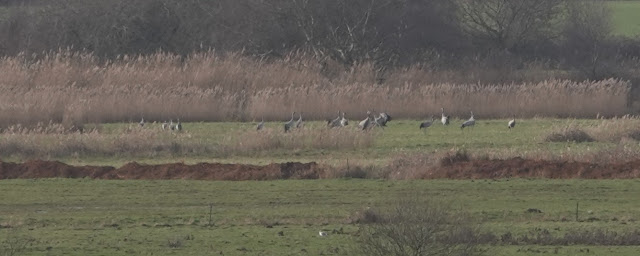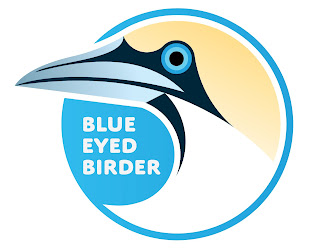A www.blueeyedbirder.com adventure:
The crew met promptly at Filby Broad for a chilly 8am start.
There had been a glorious sunrise on the drive up and a large covey of
Red-legged Partridges before reaching the village.
The light here can be tricky so I wanted to be able to scan the
area before the sun moved around. A
small group of Siskins greeted us in the car park and Long-tailed and Coal Tits
with a couple of Goldcrests moved through and a striking male Sparrowhawk
briefly perched up decked out in his finest slate blue and russet livery.
Down at the Broad the light was good but unfortunately most of
the duck were way off at the back and perversely there was even an early morning
heat haze but we persevered and a chap from Leeds actually picked up the pair
of Ferruginous Ducks first as they powerfully swan along the back edge but even
at range all the salient features could be seen. A grand start.
 |
| Ferruginous Ducks |
A small flotilla of Goldeneye appeared next to us and a
Kingfisher zipper around the corner while Marsh Tits and Green Woodpeckers
could be heard. No Gibbons today though!
It was very cold in the shade of the boardwalk so we soon
headed off and made our way inland a way to St Benet’s Abbey. It was now 9.30 and there were still quite a
few ever hopeful Owltoggers along the road and in the car park.
That first thirty seconds out of the car were amazing with
bugling Cranes immediately audible and then a Short-eared Owl glided passed us
followed by six Cranes. An adult female Hen Harrier then appeared just yards
away and a further 17 Cranes followed the first with the Owl still quartering the
Abbey field.
 |
| 17 Cranes and a Short-eared Owl |
We took a few minutes to take it all in and then kitted up
and walked up to the Abbey and river bank with the sound of the Cranes still
echoing across the landscape. Further Shorties were out across the meadows and
cruising just past us with Marsh Harriers, Buzzards, Sparrowhawk and Kestrel
all in the mix.
Scanning the Thurne side of the river revealed the Crane flock with over twenty birds together in a distant field where they danced and pranced. Two youngsters were amongst them.
A walker spooked them and they were in flight and once again that
magical sound filled the air. Twenty-four
were counted this time. Most drifted back
over our side and then dropped down out of view while the rest headed west and
out of sight. A family of three then
appeared right over us taking us up to 27 birds for the site. The assembled Owltoggers never even looked up.
I can safely say that I have never had such an encounter on
British soil before. Cranes are here to stay and I know I have said it before,
but I find it one of the most powerful and evocative sounds in my mental
library of experiences. I am not sure
how to put it into words. It is almost
visceral; a sound that reverberates right through me, giving a sense of
wildness and landscape perhaps where the former may not actually be present. I
feel it rather than hear it. It makes me
smile unconditionally.
We all stood a while longer, beaming at a shared
experience. A cloud of Lapwings lifted
up from a flooded field and some tricoloured male Marsh Harriers came close,
flushing Skylarks, Meadow Pipits and Starlings from the fields while two male Skylarks
were boldly singing just above our heads by the Abbey ruins and trying to
convince us that it was actually warmer that it really was.
 |
| Skylark |
We could find no Swans bar Mutes but I was pretty sure that
I had that in hand and with a close fly by from a slight ringtail male Hen
Harrier we ambled the 200 yards back to the car from where Andrea had been merrily
papping a Short-eared Owl that had been sat on a post next to the car!
 |
| Foot cleaning |
 |
| Short-eared Owl - all ACV |
Stalham Road in Hickling once again delivered the goods with
all three Swan species on their waterlogged potato field with a lone Egyptian
Goose. We all stayed in the cars to
avoid disturbing them.
 |
| Bewick's Swan |
 |
| Whooper Swans with Bewick's Swans at the back |
 |
| Bewick's Swans |
 |
| All three Swans - ACV |
The Cattle Egrets were not with the White Parks that I saw
them with on the 20th but just up the road we found six with some
furry little Belted Galloways. It was
even on a straight bit of road with somewhere to pull off safely!
 |
| Cattle Egret - ACV |
Up onto the dune at Waxham Barns where the sky was full of
Pink-feet last week but there was not one to be seen. However, this time there were Cranes and
after finding a couple of pairs we picked up a large flock in a distant field
which once again got flushed by a dog walker.
They were quite tricky to count but when they all took to the air and
met up with the odd birds we realised that we had at least 26 in view. They were well over a mile away and yet that sound
still found its way to us.
 |
| Yet more Cranes |
Buzzards played over the dunes and Red-throated Divers and
Razorbills were dotted across a flat looking sea before lunch beckoned. We retraced our steps to Hickling and had
lunch in the car park before adding on extra layers for the walk down to Stubb Mill.
The water levels were still very high but there was a host
of wildfowl to be seen with Teal, Gadwall, Mallard and whistle winged
Shoveler. Marsh Harriers constantly kept
them on the move and were living up to their name. We looked for Bitterns but drew a blank but a
couple of pings were heard from Bearded Tits.
The sunflower field had been stripped and was bird and quite
likely seed free but the adjacent field was dotted with Starlings, Redwings and
smart Fieldfares hopping and listening intently, head on one side, for the
wiggle of a subterranean worm.
The first of several Great White Egrets briefly lifted up
and surprisingly an early Woodcock barrel rolled over the hedge line and out of
sight. We settled in to a protracted session
at the viewpoint and with calm and still conditions and good light it was set
to be a good one.
A pair of Cranes were just out for the whole time and two
more flew north toward where the big flock had been while another pair bugled
to the south. It is quite possible that
all six were different to the earlier 26 but I will be good and stick with that
count for Hickling that still left us with a total of at least 53 Cranes in one
day in the Broads.
Marsh Harriers and Common Buzzards were constantly on view
and at least 35 of the former were logged along with two male Marsh Harriers,
Kestrel and female Sparrowhawk although we did not get a Merlin this time. Chinese Water Deer and Muntjac materialised from the margins to feed and Rabbits could be seen as white flickering undertails bobbed across the meadows.
 |
| Chinese Water Deer |
A Barn Owl graced us with several protracted close circuits and Tawny Owls started up as the light went but oddly we did not see another Woodcock. Pinkfeet started moving after dark and were presumably using the still largely full moon to feed nocturnally without the constant disturbance from field cannons. Stonechat and Water Pipit were seen and eight Yellowhammers dropped into the Blackthorn scrub to roost and glowed in the last light.
 |
| Yellowhammers - a drawing from 2020 that never had an airing |
We were the last to leave and walked back in almost full dark with the sound of Pinkies, Greylags, dabbling ducks, Water Rail and distant trumpeting of Whooper Swans guiding our footsteps.
Quite a day.






















It was another fantastic day with Howard. There were many moments to savour. I think my fav though was when we arrived at St Benet’s Abbey and within seconds we saw the Cranes, the Hen Harrier and the Short Eared Owl. It wasn’t just the birds but Howard’s infectious enthusiasm which capped it. Thanks.
ReplyDelete